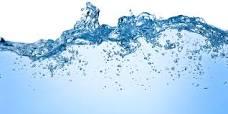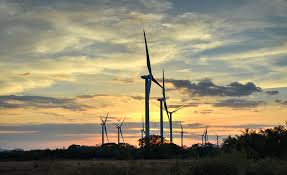Water Chemistry Elements and their Characteristics
a. Ions or mineral elements
These are dissolved minerals in water mainly present as macro and micro minerals. Macronutrients constitute about 95% in highly mineralized waters while micronutrients occur only under some conditions in trace quantities.
The quantities of minerals in water depend on their abundance in the water shed (land around the water body) and their solubility in the water.
Anions in natural waters include chloride (Cl-) and sulphate (SO42-) while cations are calcium (Ca2+), sodium (Na+), magnesium (Mg2+) and potassium (K+).
Hydrocarbonate (bicarbonate, HCO3-) and carbonates (CO32-) are present in natural waters in equilibrium with carbonic acid and dissolve from rocks like limestone, dolomite and magnesites.
At pH 7-8.5 the bicarbonate ion dominates but is close to 0 at pH less than 5 Carbonates dominate in water at pH greater than 8.
The bicarbonate or hydrocarbonate ions form carbonates with calcium ions which is less soluble.
b. Phosphorus
Phosphorus is present in natural waters in dissolved and colloidal forms depending on the pH of the water. Phosphorus occurs in very low concentrations due to low solubility of its compounds and intensive consumption by living organisms. Increases are caused by human activities
c. Ions of hydrogen
These are hydroxyl (OH-) and hydrogen (H+) ions. They result from the electrolysis of water. The reactions in water are normally expressed according to the hydrogen ions. When pH is 7, the water is neutral, less than 7 is acidic and greater than 7 basic or alkaline.
d. Dissolved gases
Dissolved gases in water are nitrogen (N), oxygen (O2), and CO2) and make up about 99.9% of dissolved gases in water.
Oxygen produced during photosynthesis is involved in most reactions occurring in water. Other gases include methane, hydrogen sulphide.
These gases result from volcanic activity, degassing of the earth’s mantle ( supplies oxides and dioxides of methane, carbon, ammonia (NH3), hydrogen sulphide (H2S), hydrogen, hydrogen chloride, sulphorous gas) in natural waters.
Thunder storm discharges nitric oxide while anthropogenic activities increase sulphorus gas, vapours of iodine, ammonia and carbonic oxide. Un-ionised hydrogen sulphide (H2S) is very toxic to fish and may also cause slow growth of fish.
Detectable concentrations of hydrogen sulphide are considered detrimental to fish production .
Nitrogen occurs in natural water as inorganic ions (ammonium-NH4+, ammonia-NH3, nitrite -NO2-, and nitrate -NO3-) and organic compounds like amino acids, protein, their metabolic wastes; products of plant and animal decay.
They are present in suspended, dissolved and colloidal forms. Conversions occur in the forms of nitrogen in water e.g. ammonia is converted under oxidizing conditions to nitrite and nitrate.
Dissolved oxygen analysis measures the amount of gaseous oxygen (O2) dissolved in an aqueous solution.
Oxygen diffuses into water from surrounding air, by aeration (rapid movement of water), and as a product of photosynthesis.
The dissolved oxygen in water should not be less than 5mg/l in farms for salmonids but carp and tilapia can withstand 3-4 mg/L DO. Warm water fish can withstand as low as 1mg/l but prolonged exposure leads to slow growth.
Dissolved oxygen is expressed as a concentration (in mg/L), or as percentage saturation(an expression of the proportion of dissolved oxygen in the water relative to the maximum concentration of oxygen that water holds at a particular temperature, pressure, and salinity).
The amount of dissolved oxygen in water depends on the water temperature. Warm water absorbs less oxygen than cold water.
e. Biogenous substances
These are substances connected by their origin with vital activities of aquatic organisms. e.g. silicon, nitrogen, phosphorus, and iron. Silicate materials are not very soluble in natural waters. They are present in both dissolved and colloidal forms.
f. Soluble organic matter
These include, sugar, acids, humic acids, tannin, vitamins, amino-acids, peptides, proteins, plant pigments, urea and many other biochemical compounds.
g. Suspended organic matter
Colloidal clay, and coarse suspensions of soil particles, colloidal or suspended remains of organisms in various stages of decay, living phytoplankton, zooplankton, fungi and bacteria.
Read Also: The Need for Effective Waste Management Policies
h. Electrical conductivity
Electrical conductivity is the measure of the ability of water to conduct an electric current. It depends on the number of ions or charged particles in the water, and is measured by passing a current between two electrodes (a known distance apart) that are placed into a sample of water.
Electrical conductivity is expressed in micro Siemens per centimetre (µS/cm) or milli Siemens per centimetre (mS/cm) and provides a direct indication of dissolved ionic matter in the water.
Low values characterize high-quality, low-nutrient waters.
High values of conductance indicate salinity problems but also are observed in eutrophic waterways where plant nutrients are in greater abundance.
Very high values are good indicators of possible polluted sites. A sudden change in electrical conductivity can indicate a direct discharge or other source of pollution into the water.
However, electrical conductivity readings do not provide information on the specific ionic composition and concentrations in the water.
i. Ph
The pH of water is the concentration of hydrogen ions, expressed as a negative logarithm. It shows the acidity or alkalinity of water.
At a pH of 7, water is neutral; lower pH levels indicate increasing acidity, while pH levels higher than 7 indicate increasing alkalinity.
At high or low pH, toxicants may become more or less available in water which may be toxic to aquatic organisms. The acid death point of organisms is at pH 4 while the alkaline death point is pH 11.
The desirable range for fish production is 6.5-9.0 at daybreak .
j. Salinity
Concentrations of ions in water and is usually expressed in parts per thousand (PPT, ‰). Classes of salinity for water are fresh water (less than 5%), brackish water (from 5% to 25%), saline water (from 25% to 36%), Super-saline (or hyper-saline) water (greater than 36%, more saline than seawater).
Open ocean salinities are generally in the range between 32 ‰ and 37 ‰.
k. Temperature
Water temperature regulates various biochemical reactions that affect water quality. Heat sources and sinks to a water body include incident solar radiation, back radiation, evaporative cooling and heat
conduction, thermal dischargers (e.g. cooling water from power plants), tributary inflows and groundwater discharge.
Since the solubility of dissolved oxygen decreases with increasing water temperature, high water temperatures limit the availability of dissolved oxygen for aquatic life.
l. Turbidity
Turbidity is a measure of the clarity of a water body. It is an optical measurement that compares the intensity of light scattered by a water sample with the light scattered by a standard reference suspension.
Turbidity is caused by suspended and colloidal matter e.g. clay, silt, finely divided organic, inorganic matter, plankton and other microscopic organisms.
It is commonly recorded in nephelometric turbidity units (NTUs).Turbidity restricts light penetration and limits photosynthesis.
m. Total suspended solids (TSS)
Total suspended solids (TSS) is the portion of total solids in a water sample retained by a glass fibre (GF/C) filter of pore size >2 µm.
Once the filter has been dried at 103-105°C and weighed, the amount of total suspended solids is recorded in units of mg/L.
n. Volatile suspended solids (VSS)
Volatile suspended solids (VSS) is the portion of total suspended solids (TSS) lost on ignition (heating to 550°C). It gives an idea of the amount of organic matter present in the solid fraction of waste water, activated sludge or industrial wastes.



